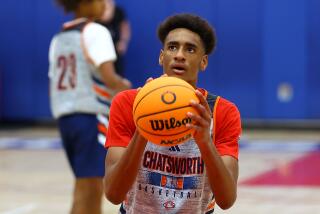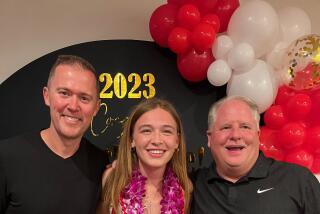Comeback Kid
- Share via
Glen McGowan calls it his “little treasure chest.”
It is a metal case filled with photos, newspaper articles, family mementos, and something precious in its own way -- the names and phone numbers of all of his doctors.
McGowan is a 6-foot-9 Pepperdine senior forward who had an eye-catching 31-point, 22-rebound performance against Colorado State last week and averages 21 points and almost nine rebounds.
Two years ago, he underwent multiple surgeries to dissolve a blood clot in his left arm and to remove the top rib on each side of his body to relieve the unusual compression of nerves and blood vessels that caused the clot.
McGowan appeared in only one game that season, recovering from October knee surgery to make his debut in a December game against Oregon, only to discover after the game that he had a far more serious condition.
“I think I had seven points and six rebounds, and I fouled out real early in the second half,” McGowan said.
“My arm was swollen that night, and the team doctor told me I had to go to the emergency room. They told me I had a blood clot and thoracic outlet syndrome. I’d never heard of it.
“I was like, ‘You’ve got to be kidding me. I’ve got a plane to catch to go to the Stanford tournament.’ They said, ‘You don’t understand how serious this is.’ ”
Lying in a hospital bed seven days later, he understood fully.
“I had my first surgery Dec. 21, and my next rib was removed a month later, Jan. 19, 2003,” he said. “It’s a very painful surgery. It felt like somebody was stepping on my chest when I was trying to recover.”
The surgeon who performed the operations, Samuel Ahn, a professor of surgery and chief of endovascular surgery at UCLA, said thoracic outlet syndrome is a rather common problem in athletes that often goes unrecognized.
“Though perhaps 20% to 50% of the population is predisposed to the condition, particularly in cases of repetitive stress, athletes are susceptible because of overuse and the buildup of muscles in the triangular area of the upper body bounded by the collarbone, the top ribs and certain muscles,” Ahn said.
“We see it in factory workers and people who use their arms a lot -- plumbers, carpenters,” Ahn said. “Those people usually have nerve compression but don’t develop blood clots because they stop when they feel pain or numbness.
“These athletes are young, naive, motivated and have an attitude of ‘No pain, no gain.’ ”
Ahn said he identifies thoracic outlet syndrome in several UCLA athletes a year, and cited David Cone, the former major league pitcher who underwent surgery in 1996 because of an aneurysm in his right shoulder, and J.R. Richard, the Houston Astro pitcher whose career was ended by a stroke in 1980, as other athletes affected.
“Most people don’t die of this,” Ahn said. “They can, but it’s unusual. Most of the time, because of the pain and numbness and tingling, they stop and see a doctor before they get a clot.”
The surgery can be risky, and the recovery is always painful.
“I tell my patients before the operation that when you wake up, you’re going to feel like somebody beat you up and broke your ribs in two places, because that’s what we did, in a very precise, controlled fashion,” Ahn said.
For McGowan, the situation was even more scary because weeks earlier he had seen teammate Will Kimble faint during a practice in November because of what was later identified as a life-threatening heart condition.
“I was petrified. It was crazy,” McGowan said. “I prayed to God. I’ve always been pretty religious.
“Just in the back of my mind, I thought, ‘I know I can get over this hump,’ ” McGowan said.
Kimble never received clearance to play at Pepperdine again, but he resumed his career this season at Texas El Paso and has started 10 of 15 games.
“He’s playing this year and doing great,” said McGowan, who regrets that the two are linked in memory by a scuffle in the library in 2001 that led to a brief suspension for McGowan. “Me and Will are good friends.”
At 23, McGowan is in his fifth season at Pepperdine after playing at Venice High and Notre Dame Prep in Fitchburg, Mass., before arriving at Pepperdine in 2000 and later sitting out one season because of his medical condition.
Though NBA scouts are taking a look at him, he tries not to look too far ahead.
“I’m taking it one day at a time,” he said. “The NBA, NBA scouts.... I’m just playing right now to better my team and better myself. We’ll see. I’m hoping an NBA team will like me.”
Pepperdine Coach Paul Westphal sees a player “in the best shape he’s ever been in,” and is pleased by McGowan’s improved rebounding.
“He’s worked hard this year,” Westphal said. “He can use the energy to go get rebounds and still have energy to play defense and score. He’s put together a sensational season.
“The poor guy has had so many things. So many weird injuries.... He deserves to have a healthy season to show what he can do.”
McGowan is thankful for that, but his outlook is not typical.
“It’s not all about basketball,” he said. “We have troops overseas fighting for our country, tsunamis across the world. Life is real. You can’t take nothing for granted.”
Because he understands that, McGowan carefully follows his doctors’ advice and takes aspirin as a blood thinner to prevent against any possibility of another clot.
“I take my baby aspirin every day -- the little orange ones, one a day,” he said.
Times staff writer Eric Stephens contributed to this report.
More to Read
Go beyond the scoreboard
Get the latest on L.A.'s teams in the daily Sports Report newsletter.
You may occasionally receive promotional content from the Los Angeles Times.










